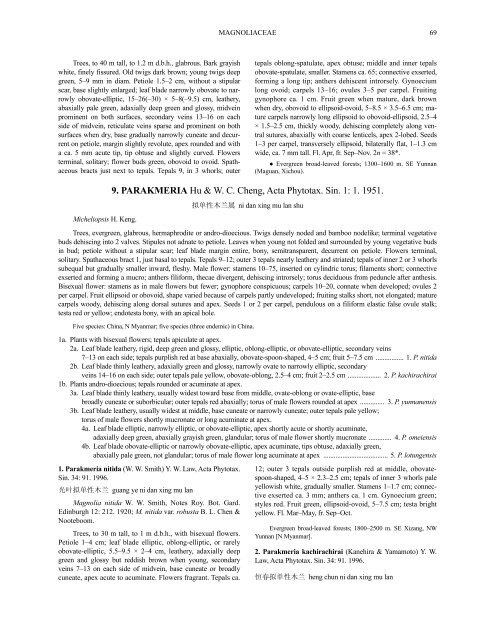Magnoliaceae (PDF)
Magnoliaceae (PDF)
Magnoliaceae (PDF)
Create successful ePaper yourself
Turn your PDF publications into a flip-book with our unique Google optimized e-Paper software.
Trees, to 40 m tall, to 1.2 m d.b.h., glabrous. Bark grayish<br />
white, finely fissured. Old twigs dark brown; young twigs deep<br />
green, 5–9 mm in diam. Petiole 1.5–2 cm, without a stipular<br />
scar, base slightly enlarged; leaf blade narrowly obovate to narrowly<br />
obovate-elliptic, 15–26(–30) × 5–8(–9.5) cm, leathery,<br />
abaxially pale green, adaxially deep green and glossy, midvein<br />
prominent on both surfaces, secondary veins 13–16 on each<br />
side of midvein, reticulate veins sparse and prominent on both<br />
surfaces when dry, base gradually narrowly cuneate and decurrent<br />
on petiole, margin slightly revolute, apex rounded and with<br />
a ca. 5 mm acute tip, tip obtuse and slightly curved. Flowers<br />
terminal, solitary; flower buds green, obovoid to ovoid. Spathaceous<br />
bracts just next to tepals. Tepals 9, in 3 whorls; outer<br />
Micheliopsis H. Keng.<br />
MAGNOLIACEAE<br />
tepals oblong-spatulate, apex obtuse; middle and inner tepals<br />
obovate-spatulate, smaller. Stamens ca. 65; connective exserted,<br />
forming a long tip; anthers dehiscent introrsely. Gynoecium<br />
long ovoid; carpels 13–16; ovules 3–5 per carpel. Fruiting<br />
gynophore ca. 1 cm. Fruit green when mature, dark brown<br />
when dry, obovoid to ellipsoid-ovoid, 5–8.5 × 3.5–6.5 cm; mature<br />
carpels narrowly long ellipsoid to obovoid-ellipsoid, 2.5–4<br />
× 1.5–2.5 cm, thickly woody, dehiscing completely along ventral<br />
sutures, abaxially with coarse lenticels, apex 2-lobed. Seeds<br />
1–3 per carpel, transversely ellipsoid, bilaterally flat, 1–1.3 cm<br />
wide, ca. 7 mm tall. Fl. Apr, fr. Sep–Nov. 2n = 38*.<br />
● Evergreen broad-leaved forests; 1300–1600 m. SE Yunnan<br />
(Maguan, Xichou).<br />
9. PARAKMERIA Hu & W. C. Cheng, Acta Phytotax. Sin. 1: 1. 1951.<br />
拟单性木兰属 ni dan xing mu lan shu<br />
Trees, evergreen, glabrous, hermaphrodite or andro-dioecious. Twigs densely noded and bamboo nodelike; terminal vegetative<br />
buds dehiscing into 2 valves. Stipules not adnate to petiole. Leaves when young not folded and surrounded by young vegetative buds<br />
in bud; petiole without a stipular scar; leaf blade margin entire, bony, semitransparent, decurrent on petiole. Flowers terminal,<br />
solitary. Spathaceous bract 1, just basal to tepals. Tepals 9–12; outer 3 tepals nearly leathery and striated; tepals of inner 2 or 3 whorls<br />
subequal but gradually smaller inward, fleshy. Male flower: stamens 10–75, inserted on cylindric torus; filaments short; connective<br />
exserted and forming a mucro; anthers filiform, thecae divergent, dehiscing introrsely; torus deciduous from peduncle after anthesis.<br />
Bisexual flower: stamens as in male flowers but fewer; gynophore conspicuous; carpels 10–20, connate when developed; ovules 2<br />
per carpel. Fruit ellipsoid or obovoid, shape varied because of carpels partly undeveloped; fruiting stalks short, not elongated; mature<br />
carpels woody, dehiscing along dorsal sutures and apex. Seeds 1 or 2 per carpel, pendulous on a filiform elastic false ovule stalk;<br />
testa red or yellow; endotesta bony, with an apical hole.<br />
Five species: China, N Myanmar; five species (three endemic) in China.<br />
1a. Plants with bisexual flowers; tepals apiculate at apex.<br />
2a. Leaf blade leathery, rigid, deep green and glossy, elliptic, oblong-elliptic, or obovate-elliptic, secondary veins<br />
7–13 on each side; tepals purplish red at base abaxially, obovate-spoon-shaped, 4–5 cm; fruit 5–7.5 cm ................ 1. P. nitida<br />
2b. Leaf blade thinly leathery, adaxially green and glossy, narrowly ovate to narrowly elliptic, secondary<br />
veins 14–16 on each side; outer tepals pale yellow, obovate-oblong, 2.5–4 cm; fruit 2–2.5 cm ................... 2. P. kachirachirai<br />
1b. Plants andro-dioecious; tepals rounded or acuminate at apex.<br />
3a. Leaf blade thinly leathery, usually widest toward base from middle, ovate-oblong or ovate-elliptic, base<br />
broadly cuneate or suborbicular; outer tepals red abaxially; torus of male flowers rounded at apex .............. 3. P. yunnanensis<br />
3b. Leaf blade leathery, usually widest at middle, base cuneate or narrowly cuneate; outer tepals pale yellow;<br />
torus of male flowers shortly mucronate or long acuminate at apex.<br />
4a. Leaf blade elliptic, narrowly elliptic, or obovate-elliptic, apex shortly acute or shortly acuminate,<br />
adaxially deep green, abaxially grayish green, glandular; torus of male flower shortly mucronate ............. 4. P. omeiensis<br />
4b. Leaf blade obovate-elliptic or narrowly obovate-elliptic, apex acuminate, tips obtuse, adaxially green,<br />
abaxially pale green, not glandular; torus of male flower long acuminate at apex ..................................... 5. P. lotungensis<br />
1. Parakmeria nitida (W. W. Smith) Y. W. Law, Acta Phytotax.<br />
Sin. 34: 91. 1996.<br />
光叶拟单性木兰 guang ye ni dan xing mu lan<br />
Magnolia nitida W. W. Smith, Notes Roy. Bot. Gard.<br />
Edinburgh 12: 212. 1920; M. nitida var. robusta B. L. Chen &<br />
Nooteboom.<br />
Trees, to 30 m tall, to 1 m d.b.h., with bisexual flowers.<br />
Petiole 1–4 cm; leaf blade elliptic, oblong-elliptic, or rarely<br />
obovate-elliptic, 5.5–9.5 × 2–4 cm, leathery, adaxially deep<br />
green and glossy but reddish brown when young, secondary<br />
veins 7–13 on each side of midvein, base cuneate or broadly<br />
cuneate, apex acute to acuminate. Flowers fragrant. Tepals ca.<br />
12; outer 3 tepals outside purplish red at middle, obovatespoon-shaped,<br />
4–5 × 2.3–2.5 cm; tepals of inner 3 whorls pale<br />
yellowish white, gradually smaller. Stamens 1–1.7 cm; connective<br />
exserted ca. 3 mm; anthers ca. 1 cm. Gynoecium green;<br />
styles red. Fruit green, ellipsoid-ovoid, 5–7.5 cm; testa bright<br />
yellow. Fl. Mar–May, fr. Sep–Oct.<br />
Evergreen broad-leaved forests; 1800–2500 m. SE Xizang, NW<br />
Yunnan [N Myanmar].<br />
2. Parakmeria kachirachirai (Kanehira & Yamamoto) Y. W.<br />
Law, Acta Phytotax. Sin. 34: 91. 1996.<br />
恒春拟单性木兰 heng chun ni dan xing mu lan<br />
69

















